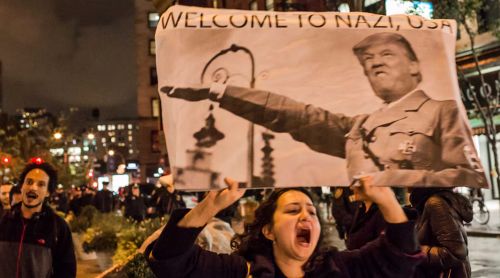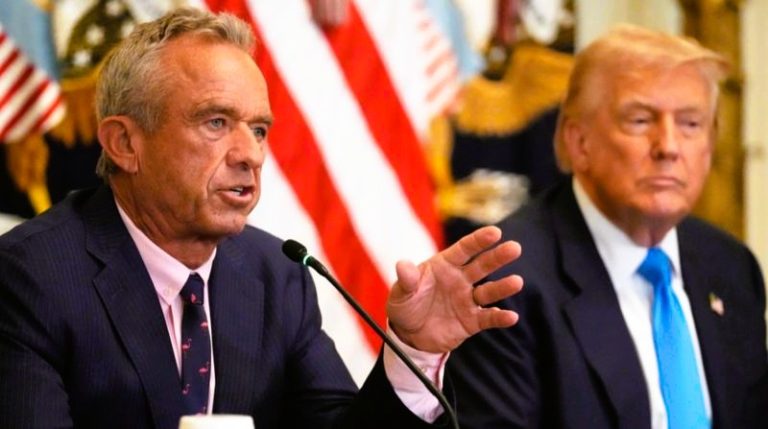

White supremacy, fascist rhetoric, and eugenic ideology are no longer fringe elements hiding at the margins of MAGA, they are central to the movement’s identity.

By Matthew A. McIntosh
Public Historian
Brewminate
Introduction: Extremism Moves From the Fringe to the Center
White supremacy and fascist rhetoric, once confined to the outer edges of U.S. politics, have re-entered mainstream conservative discourse through the MAGA movement. What began as fringe extremism now shapes messaging, online spaces, and internal party culture. White supremacist ideas have resurfaced visibly in national politics, while MAGA identity is increasingly organized around racial exclusivity. At the same time, private online chats among young GOP club members have been revealed in which participants shared Hitler memes, praised fascism, and traded openly racist messages, signs that extremism is not just tolerated but normalized in certain corners of the movement.
This resurgence is not limited to hidden channels. Public-facing commentary and political rhetoric have intensified racial hierarchies, Christian nationalist framing, and xenophobic messaging. Unchecked extremism is “tearing the MAGA movement apart,” joined by the amplification of Islamophobic and antisemitic narratives by prominent right-wing media figures. These dynamics mirror patterns historically associated with authoritarian and fascist movements, where targeted hatred becomes a rallying tool rather than something condemned.
The return of this ideology also intersects with Trump’s long-standing embrace of eugenics-styled rhetoric, including repeated references to “good genes,” themes that Monthly Review identifies as overlapping with white supremacist narratives about biological hierarchy. Meanwhile, race relations have worsened significantly under Trump’s leadership, shaped by divisive messaging and policies that fuel hostility rather than unity. Across these sources, one trend becomes unmistakably clear: bigotry is no longer a fringe element of MAGA; it has become one of its defining features.
Private GOP Spaces Reveal Explicit Extremism
The growing extremism inside the MAGA movement is most clearly visible in the private digital spaces where young Republican activists and club members communicate. Reporting revealed leaked group chats from the Young Republicans club in which members casually shared Hitler memes, praised fascism, and circulated explicitly racist messages. Screenshots obtained by the outlet show participants posting Nazi iconography, making jokes about mass murder, and openly admiring authoritarian leaders. These exchanges were not isolated incidents but part of ongoing conversations that reflected a shared comfort with white supremacist and fascist symbolism.
What stands out in the reporting is the near-total absence of internal pushback. Club leadership knew about the content circulating in its channels but did not discipline the members involved. In some cases, individuals responsible for posting extremist material continued to hold leadership roles. The investigation found no meaningful effort to distance the organization from the rhetoric, reinforcing the sense that such views are tolerated, or at least not seen as disqualifying, within certain corners of the young Republican ecosystem.
The story points to a deeper normalization of extremist ideas. Rather than being treated as disqualifying or dangerous, fascist references and white supremacist content appear in these group chats as jokes, bonding rituals, or expressions of political identity. Some participants defended the content as “ironic” or “edgy,” a strategy that mirrors patterns seen in extremist online communities where irony is used to mask sincere ideological commitment. The language and imagery circulating in these spaces reflect a political culture where boundaries that once separated mainstream conservatism from explicit bigotry have eroded dramatically.
The lack of accountability within the organization also highlights a larger trend documented across your sources: that the MAGA movement’s internal spaces often serve as incubators for extremist ideology. The private nature of these chats allows members to express views they might avoid publicly, revealing a candid enthusiasm for authoritarian and racist ideas. The problem is not limited to anonymous trolls or fringe outliers; it includes young Republicans in formal political clubs, preparing to become the next generation of conservative leadership.
The Mainstreaming of White Supremacy in MAGA Politics
White supremacist ideology has not only resurfaced but has become intertwined with the mainstream rhetoric of the MAGA political landscape. Ideas once associated with extremist groups are now openly circulated in conservative political messaging, public speeches, and online networks aligned with Trump’s movement. The report documents how racial hierarchy, anti-immigrant narratives, and conspiratorial takes on demographic change have become regular features of MAGA discourse. These themes do not exist at the fringes; they are woven into the movement’s identity and reinforced through its most influential voices.
This shift is not accidental. MAGA identity politics increasingly revolve around race, presenting “white, preferably racist” identity as a core political appeal. The article argues that this racial exclusivity is not peripheral but central to how the movement defines belonging and political loyalty. By treating whiteness as an organizing principle, the movement positions itself as a defender of a particular ethnic and cultural hierarchy, a strategy that energizes supporters already primed by years of divisive rhetoric.
The mainstreaming of these ideas is accelerated by the constant overlap between political actors, online communities, and conservative media outlets. Talking points about “replacement,” “decline,” and “threats” tied to racial and religious minorities circulate widely across MAGA-affiliated platforms. These narratives mirror well-documented white supremacist conspiracy theories, yet they are repackaged as concerns about culture, national identity, or security. This allows extremist rhetoric to blend seamlessly with party messaging, giving it legitimacy and reach.
These racial hierarchies shape policy preferences. Whether discussing immigration restrictions, policing, voting rights, or education, MAGA-aligned politicians frequently frame their positions in ways that favor a white-dominant vision of America. The rhetoric emphasizes “taking back” the country, “restoring” its identity, and resisting demographic changes, language that historically fueled segregationist and white nationalist movements. By presenting these ideas as patriotic rather than extremist, the movement softens their appearance while expanding their influence.
White supremacist ideology has moved far beyond isolated incidents or individual extremists. It now forms a recognizable part of the MAGA political worldview, amplified through speeches, policy framing, and media narratives. This mainstreaming of bigotry creates fertile ground for more explicit forms of racism and authoritarianism to flourish, setting the stage for the even more alarming rhetoric documented in subsequent sections.
MAGA Identity Politics and the “White-Nation” Framework
The process of reshaping MAGA identity around racial exclusivity is well-documented in the reporting you provided. The movement’s core political identity is increasingly built around the idea of a “white nation,” where belonging is defined through racial preference and exclusion. MAGA messaging frames whiteness not just as a demographic fact but as a political virtue, positioning white Americans as the rightful inheritors of national power. This framing encourages supporters to see demographic diversity as a threat rather than a strength, fueling narratives that cast the country as slipping away from those who “should” control it.
This racialized identity politics does not operate in the abstract. Extremism within MAGA spaces frequently goes unchecked, creating an environment where racist and xenophobic ideas spread without challenge. The outlet’s commentary highlights how online MAGA communities often serve as echo chambers for arguments about national purity, cultural preservation, and the need to protect America from “outsiders,” language that mirrors historic white nationalist rhetoric. The lack of internal pushback allows these narratives to circulate freely, gradually shaping the worldview of supporters who absorb them as common sense rather than extremist ideology.
These patterns extend directly into right-wing media. High-profile conservative commentators amplify Islamophobic and antisemitic messages under the guise of cultural critique or political analysis. Through selective framing, vilification, and fear-based storytelling, these figures intensify the sense that religious and ethnic minorities pose a threat to the nation’s identity. These narratives are increasingly woven into broader MAGA messaging, creating a seamless fusion of white identity politics, religious nationalism, and targeted bigotry.
The combined effect is a political culture where racism is not merely tolerated but is actively woven into the movement’s self-definition. MAGA identity is marketed through nostalgia (visions of an America that was “stronger,” “purer,” or “more unified”) ideas that historically encoded racial exclusion. This backward-looking nationalism provides an emotional framework that magnifies resentment, making policies that restrict immigration, undermine minority civil rights, or elevate Christian nationalism feel like logical extensions of the movement’s goals.
Taken together, the reporting shows that MAGA identity politics operate through an explicit racial lens. Rather than concealing its exclusionary core, the movement increasingly embraces it, drawing on white nationalist themes to mobilize supporters and define the boundaries of political belonging. This racial exclusivity forms the ideological foundation for the more overt expressions of fascism and bigotry.
Fascist-Sympathetic Narratives in Right-Wing Media Ecosystems
As extremist rhetoric has grown inside the MAGA movement, sympathetic references to fascism and authoritarian leaders have become increasingly visible across the movement’s media channels and online spaces. MAGA-aligned communities on social platforms now regularly share material that praises or rehabilitates fascist figures, including explicit admiration for Hitler and other authoritarian leaders. According to the analysis, these messages circulate with little resistance, creating a permissive environment where fascist nostalgia is treated as edgy humor or a legitimate political point rather than a red flag of violent ideology.
This normalization is amplified by influential right-wing media personalities. Major conservative commentators use their platforms to spread Islamophobic and antisemitic narratives that mirror classic fascist propaganda strategies. The reporting highlights moments when these figures framed religious or ethnic minorities as existential threats, relying on fear-driven rhetoric that casts entire groups as disloyal, dangerous, or incompatible with the nation. Such messaging not only stokes bigotry but also reinforces the sense of crisis that authoritarian movements historically exploit.
The rhetoric blends seamlessly with the broader xenophobic messaging that defines much of MAGA’s political communication. In these ecosystems, hateful narratives are often packaged as ordinary political critique, making it difficult for casual observers to distinguish between mainstream conservative commentary and extremist ideology. This ambiguity allows fascist-aligned ideas to reach audiences who may not seek out extremist content but encounter it through curated posts, influencer commentary, or viral messaging. The result is a political ecosystem where bigotry is not only tolerated but algorithmically rewarded.
What stands out in the reporting is how these narratives draw from a familiar set of historical patterns. There are clear parallels between current right-wing messaging and earlier authoritarian communication strategies that used dehumanization, fear of the “other,” and appeals to cultural purity to justify oppressive policies. The repetition of these themes across MAGA-aligned media outlets demonstrates how such rhetoric has become embedded in the movement’s ideological DNA rather than remaining the domain of fringe extremists.
Fascist-sympathetic rhetoric has gained a foothold in MAGA media environments where misinformation, bigotry, and authoritarian nostalgia circulate without restraint. These narratives do not exist on the margins; they shape mainstream political conversations, influence grassroots activists, and create ideological conditions that make more explicit forms of white supremacist and authoritarian messaging easier to normalize.
The Ideological Blending of White Supremacy and Eugenics
Eugenic ideas have begun to merge visibly with the racial hierarchy at the core of MAGA ideology, creating a fusion of biological determinism and white nationalist politics. Trump-era rhetoric frequently draws upon themes historically associated with eugenics, especially the notion that certain groups possess superior traits that make them more valuable to the nation. According to the report, these ideas appear in discussions about “strength,” “fitness,” and demographic desirability, echoing early twentieth-century arguments that sought to rank populations by genetic worth.
This blending of eugenics with white supremacy is not abstract; it emerges directly in how the movement defines belonging and exclusion. MAGA-linked figures invoke racialized claims about intelligence, morality, and productivity, categories that eugenics once presented as biologically predetermined. The report highlights how these ideas surface in anti-immigrant messaging, demographic fearmongering, and arguments that portray certain groups as inherently threatening to American stability. By presenting race-linked attributes as fixed and hereditary, the movement reinforces narratives that align closely with historical eugenic frameworks.
The overlap becomes even clearer when viewed alongside Trump’s repeated invocation of “good genes,” which are a rhetorical link between personal identity and inherited superiority. These comments dovetail with the broader movement’s claims about which populations are “valuable,” “dangerous,” or “deteriorating.” When heredity is presented as destiny, as the reporting suggests, it invites policies that sort people by perceived biological traits rather than rights or needs, the foundational logic of eugenics.
Within MAGA-aligned discourse, these themes also intersect with anxieties about demographic change. Language about “decline,” “replacement,” and “survival” is often framed in a way that suggests certain racial groups strengthen the nation while others diminish it. This mirrors classic eugenic arguments about population quality, except now the framing appears through modern political rhetoric rather than scientific jargon. Such narratives promote the idea that protecting the nation requires protecting its “stock,” a framing historically used to justify discriminatory and exclusionary policies.
Eugenics and white supremacy are no longer distinct ideological strands within the MAGA movement. They have become interwoven, reinforcing one another through rhetoric that elevates heredity, hierarchy, and racial purity as political virtues. This ideological fusion does not rely on explicit policy proposals; it operates through narratives that frame human worth as a matter of biology, a dangerous return to ideas that once shaped some of the darkest chapters of American and global history.
Race Relations Under Trump’s Second Term
Race relations in the United States have deteriorated sharply during Trump’s second term, according to the reporting you provided. There is a measurable decline in public confidence surrounding racial equality, driven largely by the administration’s rhetoric and policy choices. The outlet notes that Trump’s messaging consistently amplifies grievance, division, and racialized fear, conditions that have historically fueled extremist organizing and political violence. These patterns have accelerated during his return to office, creating an environment where racial hostility is increasingly normalized.
Trump’s public statements routinely validate narratives embraced by white nationalist groups. Whether through aggressive rhetoric about immigrants, inflammatory comments about minority communities, or refusal to condemn extremist supporters, the reporting shows how Trump’s messaging emboldens those who traffic in racial resentment. This dynamic has contributed to a rise in openly racist political activity and a shrinking space for constructive dialogue about racial justice. At the same time, it reinforces the broader ideological trends documented across your other sources, where the movement’s core identity becomes increasingly tied to racial hierarchy.
These conditions extend beyond speech alone. Policy decisions during Trump’s second term have compounded racial tensions by undermining civil rights protections, rolling back diversity initiatives, and elevating officials whose public statements align with race-based political narratives. These actions interact directly with the extremist rhetoric circulating in MAGA communities, creating a feedback loop in which discriminatory ideas gain legitimacy through government authority. This has deepened mistrust between communities and institutions, particularly among groups historically targeted by exclusionary policies.
The overall picture drawn from the reporting is that racial hostility is not an unintended byproduct of the Trump-era political environment; it is a defining characteristic. The fusion of divisive rhetoric, permissive attitudes toward extremism, and racially inflected policy decisions has made race relations significantly worse. This shift has broad consequences for national cohesion, minority rights, and the stability of democratic institutions. It also sets the stage for the ideological culmination described in your conclusion, where white supremacy and authoritarianism move from the periphery into the center of MAGA political life.
Conclusion: A Movement Sliding Into Open Extremism
One reality becomes impossible to ignore: white supremacy, fascist rhetoric, and eugenic ideology are no longer fringe elements hiding at the margins of MAGA, they are now central to the movement’s identity. Racial hierarchy, Christian nationalist framing, and hereditarian politics are woven into MAGA’s worldview, shaping how its members understand national belonging, political legitimacy, and demographic change. This transformation is not organic; it is fed by deliberate rhetoric from Trump and amplified by aligned media ecosystems that normalize bigotry under the guise of patriotism.
At the same time, private communications and extremist commentary reveal a movement where explicit admiration for fascist leaders, racist memes, antisemitic narratives, and Islamophobic messaging circulate without resistance. These ideas are not treated as unacceptable’ they are encouraged, joked about, or used as markers of group identity. This permissiveness reinforces the broader ecosystem described in your sources, where Trump’s rhetoric emboldens supporters who see bigotry not as a liability but as a feature of their political identity.
Trump’s second term has further eroded race relations and elevated rhetoric that divides the country along racial, religious, and ideological lines. Combined with the movement’s embrace of eugenics and authoritarian nostalgia, the result is a political culture that rewards exclusion, fear, and domination. This is no longer a matter of isolated extremists or fringe online forums. It is the ideological direction of a major political movement, one that draws openly from the playbook of white supremacy and fascism, and one that poses a profound threat to democratic norms, civil rights, and the safety of marginalized communities.
Originally published by Brewminate, 11.19.2025, under the terms of a Creative Commons Attribution-NonCommercial-NoDerivatives 4.0 International license.


